Brands spend billions of dollars each year on efforts aimed at influencing consumers by following a traditional marketing model. The U.S. alone accounts for an estimated $298 billion in ad expenditures annually and was recently named the world’s largest advertising market.
Developed in 1898 by one of advertising’s founding fathers, Elias St. Elmo Lewis, the traditional marketing model narrows the consumer decision-making process into four key stages: awareness, interest, desire and action (AIDA). This model helps marketing strategies steer the consumer through each stage of the decision-making process.
Historically, advertising has been considered the most creative influencer for brands—a belief that is protected and nurtured by many of the world’s leading ad agencies. Yet the world we live in today looks much different than it did in 1898. Now consumers have access to information to form their own opinions of brands.
They are constantly connected to a free flow of information and ideas. They have become a more informed group of consumers who are learning more, engaging faster and expecting convenience and speed in every aspect of life. And marketers who were once following a linear and much more predictable progression to deliver their messages are now placed in an oversaturated, erratic maze they must learn to navigate. The shifting consumer purchasing path is shaking up the competitive dynamics in nearly all industries, including advertising.
Marketers today must adjust to the new consumer expectations or they will be left behind. The end of the linear consumer journey can be pinpointed back to 2015 when Google introduced micro-moments, which give brands exactly one minute to be where the consumer is looking to meet their need. This drastically alters the way you approach consumers, but most importantly the way you understand them. Advertising strategies were once based on a gut feeling or on the person who made the most convincing argument; today, advertisers need to adopt consumer insights. There is no argument that this new era of advertising has created a headache for buyers and sellers of advertising, and for those responsible for measuring it.
Twenty years ago, the world was a far simpler place for brand advertisers: broadcast was king and online was an emerging fad. Since the turn of the century, there has been an explosion in the availability of data. From CRM systems to big data, companies have become increasingly data driven. Mobile advertising is the fastest growing medium, although broadcast still holds the greatest market share in ad spend (Figure 1). This is largely due to mobile’s integration of data and marketing strategy. Seismic shifts in technology during the past decade have created a cookie-crumb trail following consumers as they navigate their path to purchase.
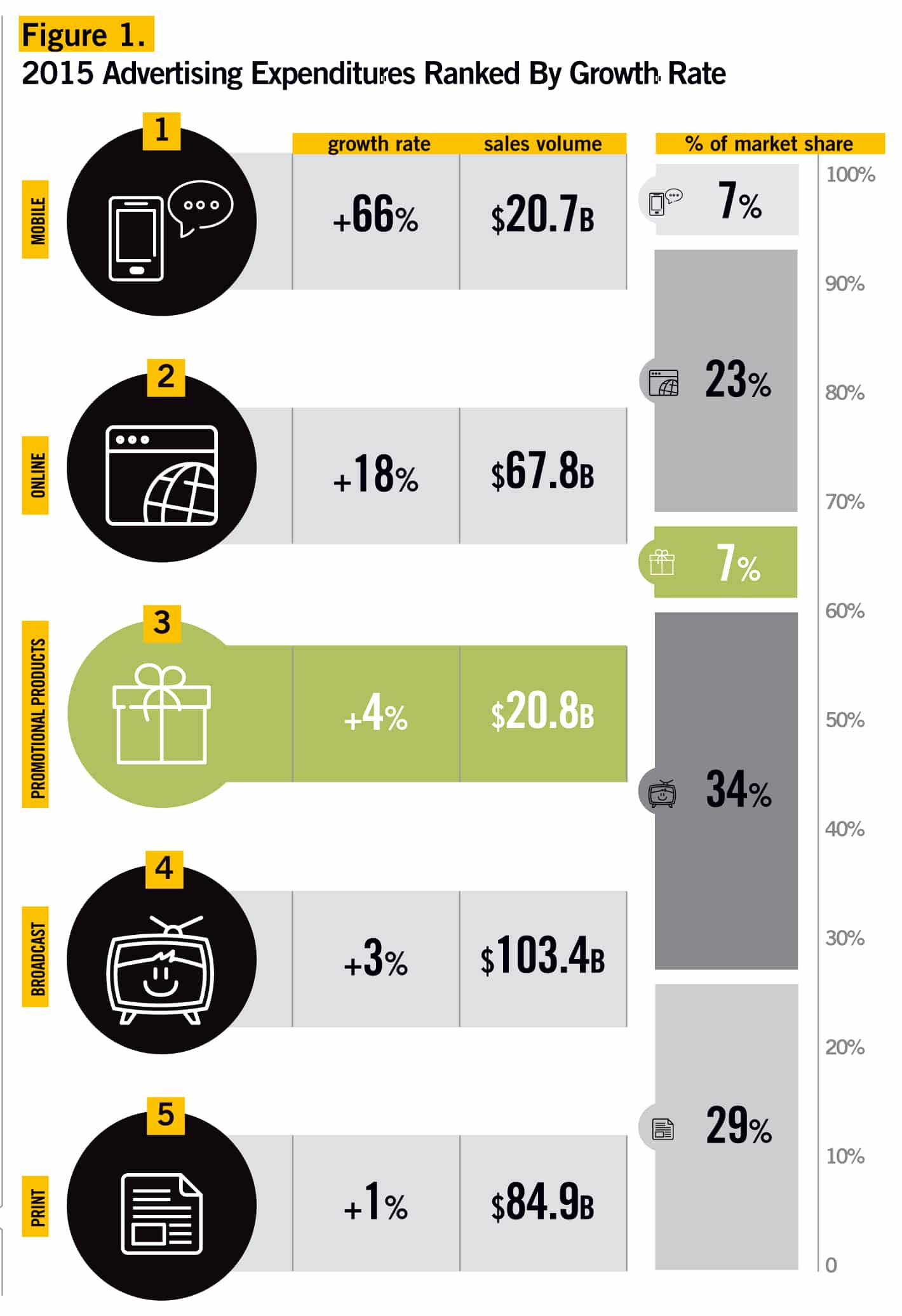
They are on tablets while watching television. They use smartphones to price compare while they shop. Crumbs are dropped at every stop. This produces a granular, nearly infinite record of what consumers see and do, which in turn enables marketers to gain access to an unprecedented level of precision—a strategy many have turned to. This streamlined approach, however, treats advertising touchpoints as if each works in isolation, causing many marketers to get lost in an unlimited flow of unfiltered data.
We live in a data-rich world, but it’s not necessarily information-rich. Customer demographics and buying patterns tell us the ‘what,’ but not the ‘why.’ To get ahead, marketers must dig deeper to capture a clearer understanding of consumers, their needs and desires. Understanding consumer insights and using numbers that truly quantify impact across platforms will be irresistible to advertisers who want the full story—and might just tip the scale as we know it.
More than ever, consumers today are driven to avoid ads (Figure 2). A reported 91 percent of consumers believe ads are more intrusive today compared to two or three years ago, and 87 percent agree there are more ads in general. They are making decisions in everyday life that revolve around whether they will be interrupted by unwanted distractions, such as paying for ad-free services. For example, Netflix users grew to nearly 94 million earlier this year and music streaming subscriptions have surpassed 100 million users. In fact, according to a recent study, 42 percent of consumers said they were “planning to pay for new solutions to remove ad interruptions” within the next year.
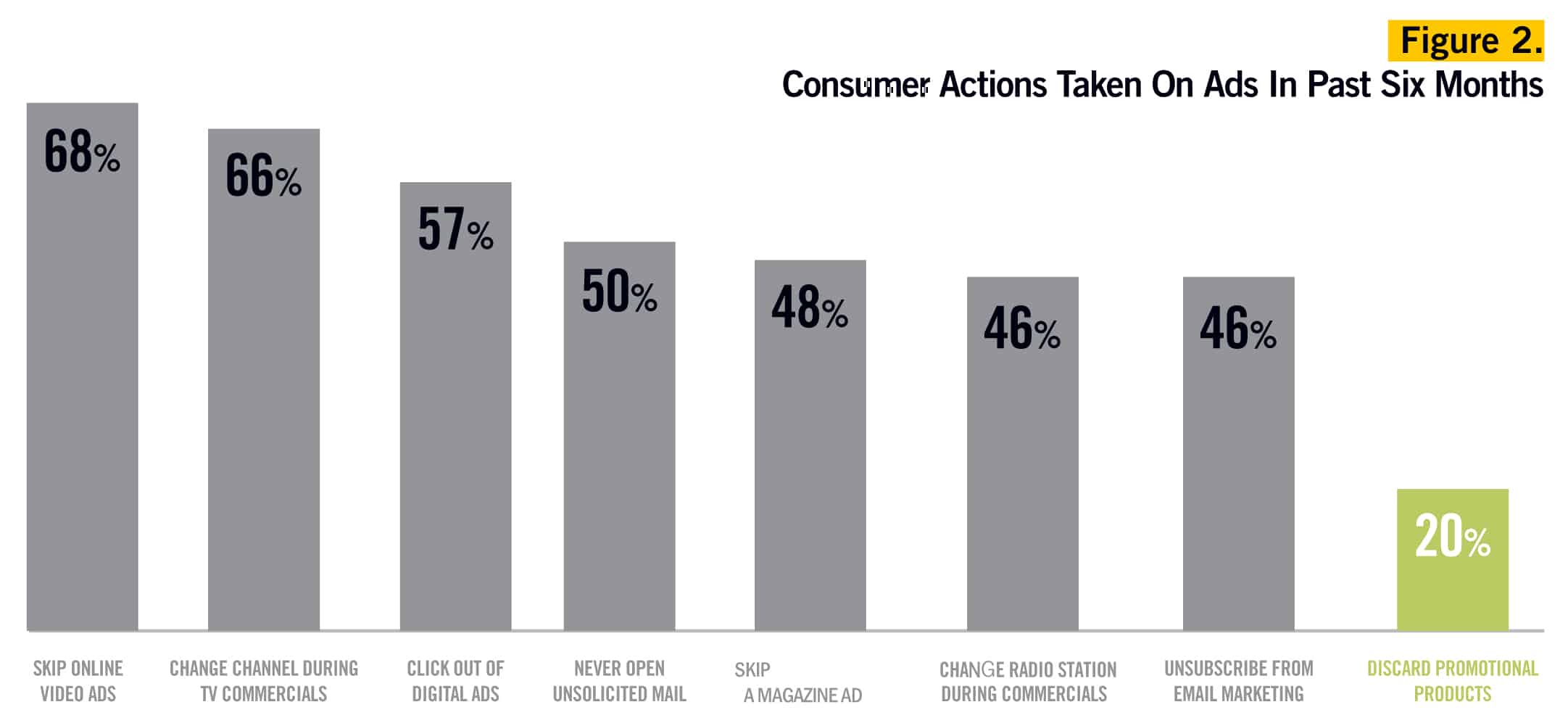
And the desire to see fewer ads is motivating these purchases. Earlier this year, Paige Fair reported that mobile ad-blocking software has grown to an estimated 380 million users and 236 million active desktop devices, indicating “interruption” as the leading reason for consumer use. Paige Fair also reported a staggering 74 percent of consumers will abandon websites that require them to disable their ad-blocker software.
An evolving challenge for marketers is overcoming ad-blocking in order to successfully connect with the target audience. Yet ad-blocking behaviors are symptoms rooted in a larger problem: consumers no longer enjoy their advertising experiences. Despite this growing pattern of ad avoidance that we see among consumers today, 83 percent agree that not all ads are bad but “they want to filter out the really obnoxious ones,” as one report stated. They want messages to catch their eye and clearly deliver a message that they can relate to and makes them think. (Figure 3).
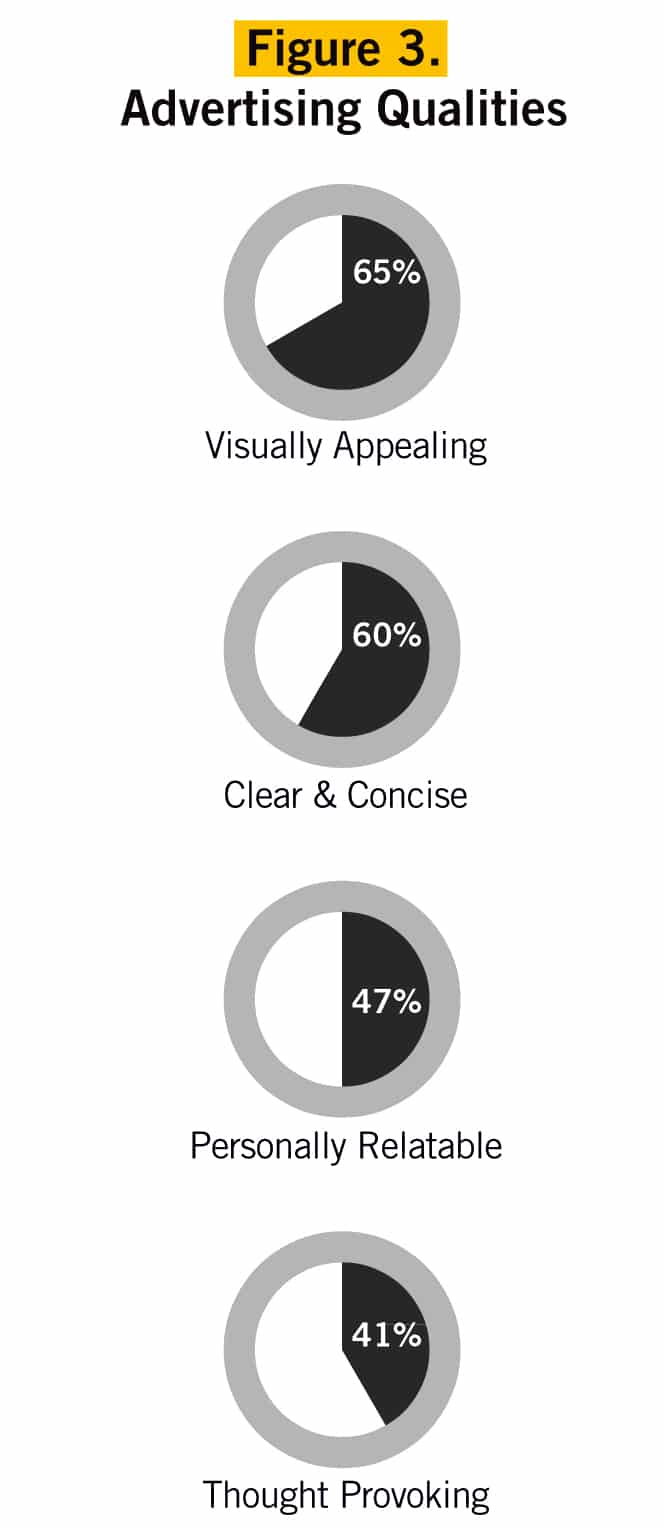
As Benjamin Franklin famously said, “Every problem is an opportunity in disguise.” Rather than forcing more unwanted advertising on consumers, it is time to reinvent how marketers communicate their messages. Following the release of a new consumer study earlier this year, PPAI has published the 2017 Ad Map presenting a comparative analysis across brand touchpoints. These are grouped into five advertising channels (Figure 4) to better examine and compare the role each plays with consumers.
Armed with this knowledge, marketers can make more informed decisions about where to invest their advertising budgets and grow their businesses. Promotional product reach is measured by consumer ownership. It is simply the percentage of consumers who have received a promotional product. The measurement of reach across advertising channels sings a different tune. Broadcast advertising chases after consumers being in the right place and at the right time.
Consumers must be watching the right channel or listening to the right station the moment a commercial airs to receive the branded message. Print advertising, on the other hand, relies on the consumer accessing the material and coming across the advertisement in the placement position.

Mobile advertising requires the consumer to download the right app in which the ad was placed, and online advertising needs to have initiated a load onto a browser to be counted in the reach calculation. Eighty-nine percent of consumers have received a promotional product in the past six months—that’s nearly nine in 10 who own a promotional product, nine in 10 who use promotional products, and nine in 10 walking billboards for a brand.
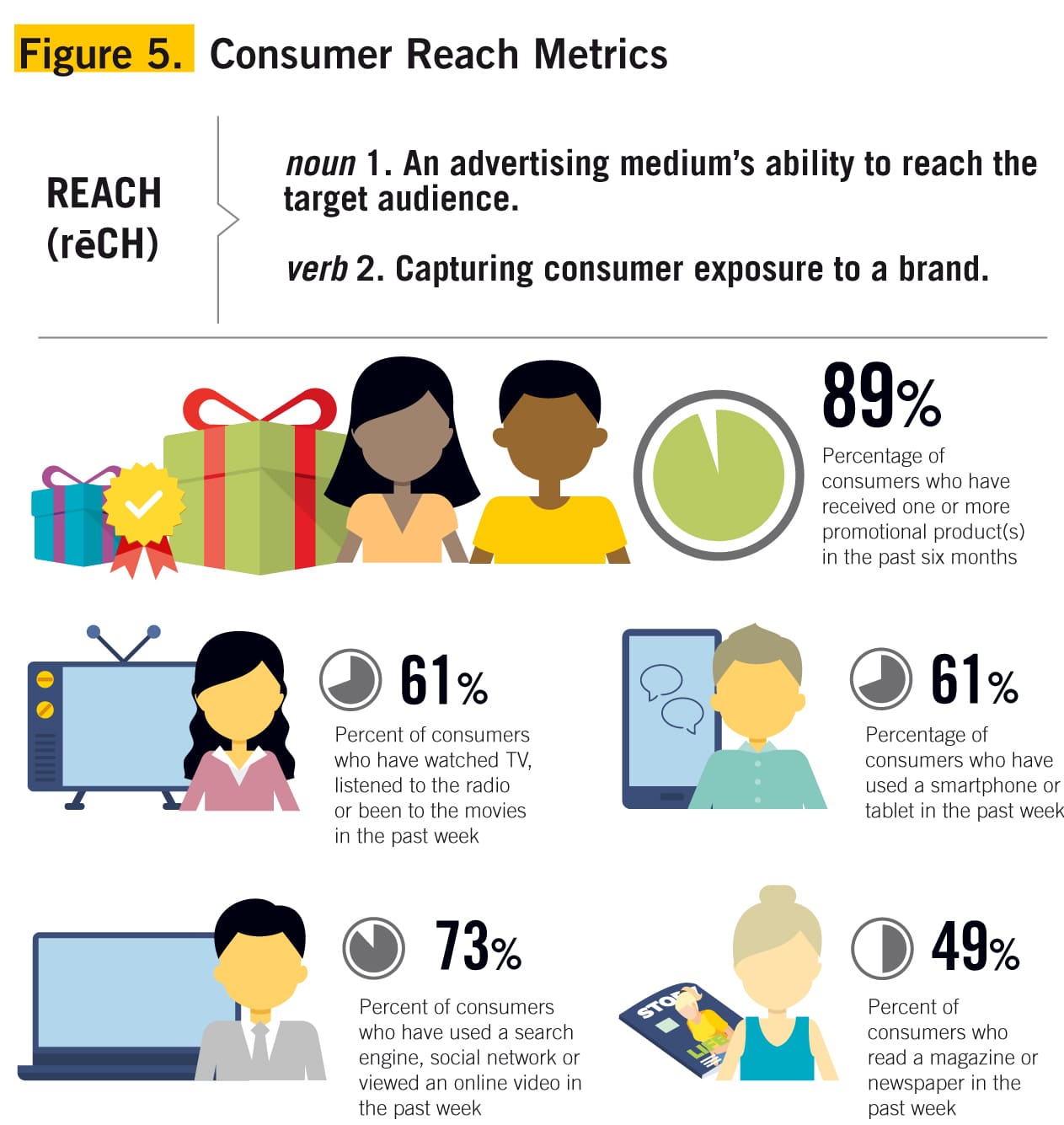
Promotional products provide brands with a reliable path to reach the target consumer group by positioning their message as it will be best received. In fact, according to PPAI research, promotional products are the most welcomed form of advertising by all generations and considered most effective in providing a rationale to respond (Figure 6).
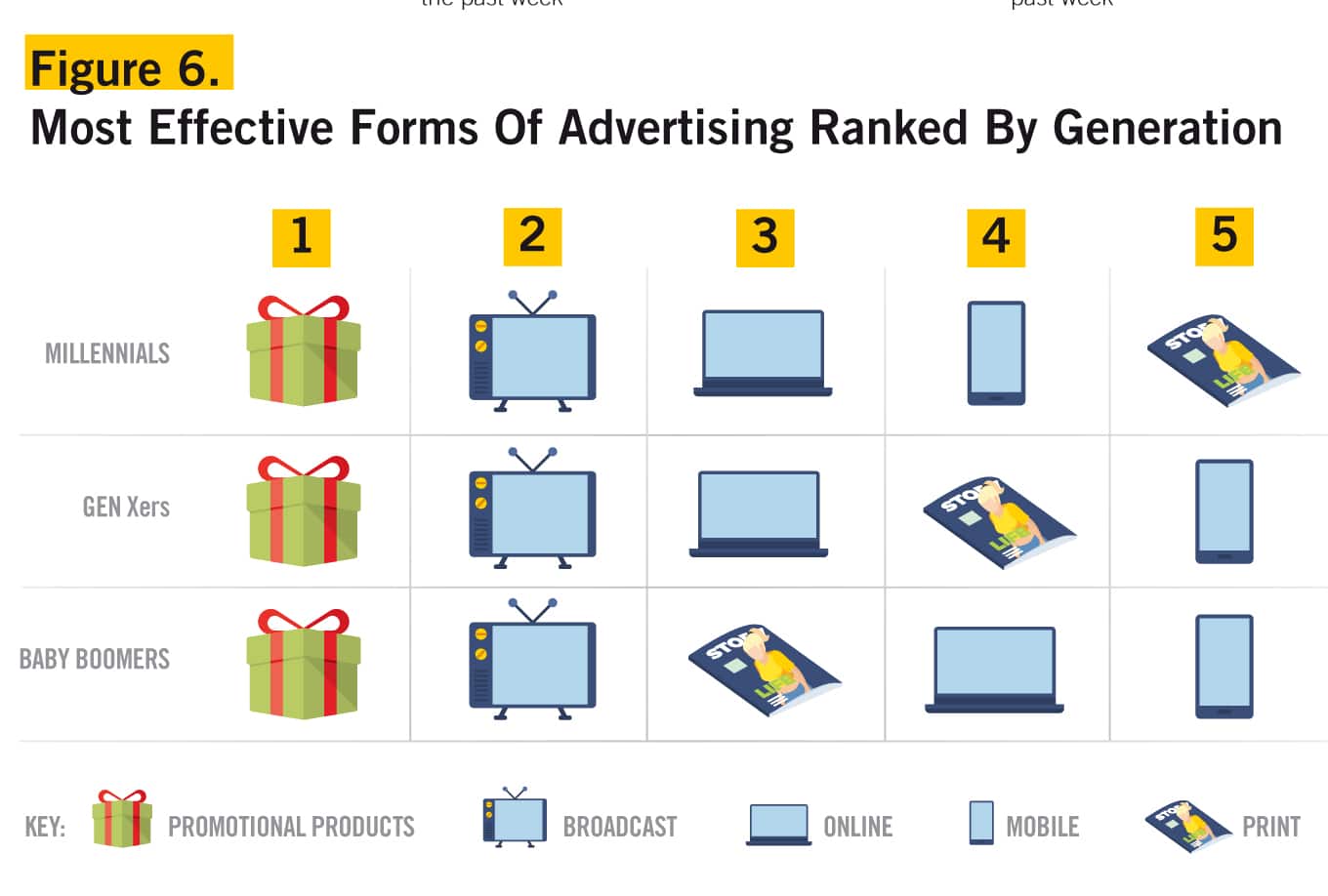
Promotional products not only allow brand messages to effectively reach their intended audience, they also spread the word to anyone who sees the product displayed, used or shared.
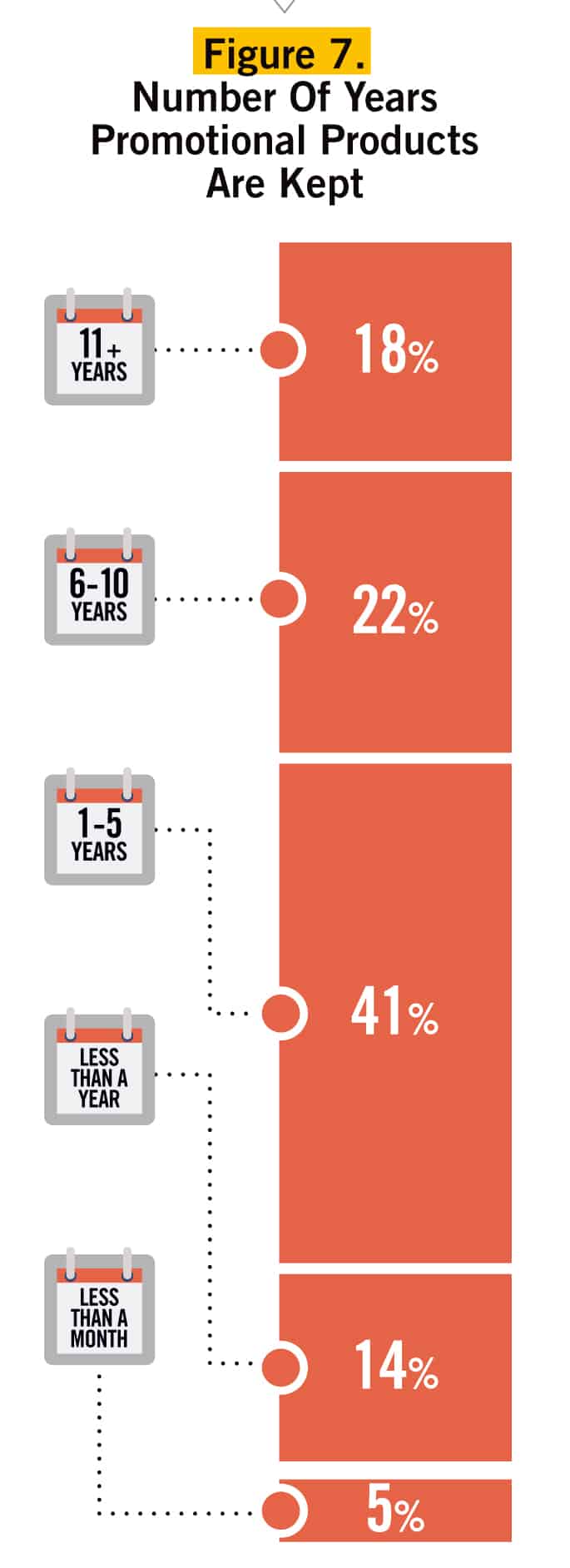
Promotional products are used daily, and 83 percent of consumers use them more than once a day. The longer a promotional product is kept, the longer a brand’s message is communicated. And if a recipient does not want or need the promotional product, eight in 10 pass it along (nearly seven in 10 give it to someone they know, and one in three will donate it) ultimately furthering the brand’s reach. Because of their extended shelf life and their ability to be used in everyday activities, promotional products allow consumers an opportunity to absorb the content at the pace and time they choose.
This presents a greater opportunity for brands to engage with consumers without forcing unsolicited advertising. The race to win the consumer path to purchase is contingent on consumers being able to actually remember the brand at the point of purchase. If they can’t recall a brand, they are less likely to buy the brand. Ensuring recall relies on building consumer memory, which can be carried out by brand exposure (through advertising) or brand experience (through using the brand’s products or services).
Promotional products have an upper hand on other forms of advertising because they are the only medium that offers an additional opportunity to heighten consumer memory. By replacing everyday items they are already using with branded promotional products, advertising assumes a more functional role in consumers’ everyday lives. This heightens both brand exposure and brand experience, allowing a greater memory recall.
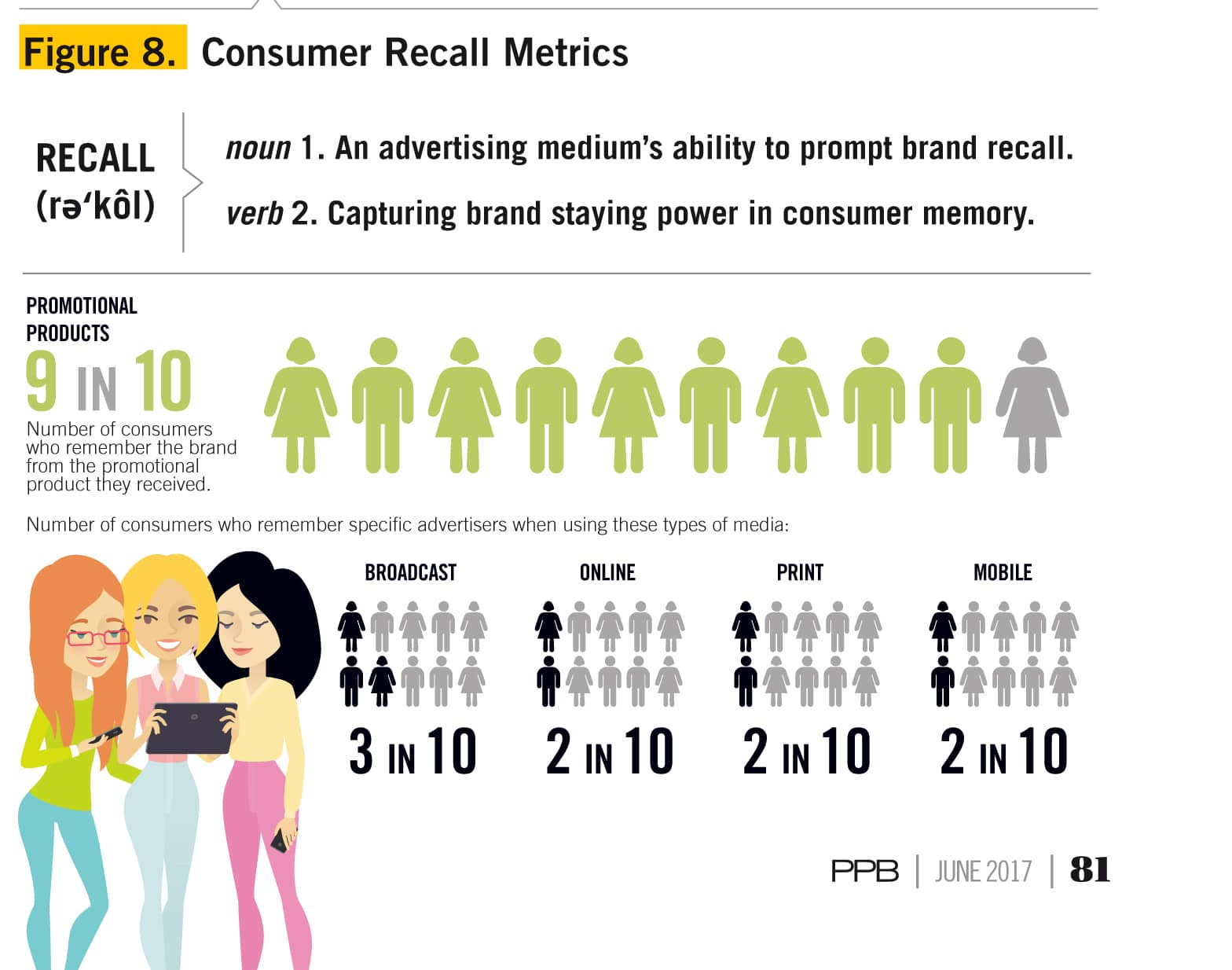
The PPAI study shows nine in 10 consumers recall the branding on promotional products they have received—and it’s 67 percent higher than broadcast advertising and 78 percent higher than online, print and mobile advertising. It’s clear that promotional products pave the way for brands on the consumer path to purchase. Reaction measures consumer purchase influence, which are actions taken as a result of advertising; however, there is no longer one large platform holding the majority of consumer influence.
Marketers are now faced with a consumer group seeking to enrich themselves and explore their interests so they can build and pursue their purpose. They don’t just consume; they create their own content and curate that of others at lightning speed. And now, more than ever, they are spoiled with the means to do so. As a result, consumers are choosing to engage only with content that is personally relevant to them, their passions and their purpose. This new consumer mindset directly translates in the consumer path to purchase—consumers shop with the same purpose they consume and the path to purchase becomes the consumer’s path to purpose.
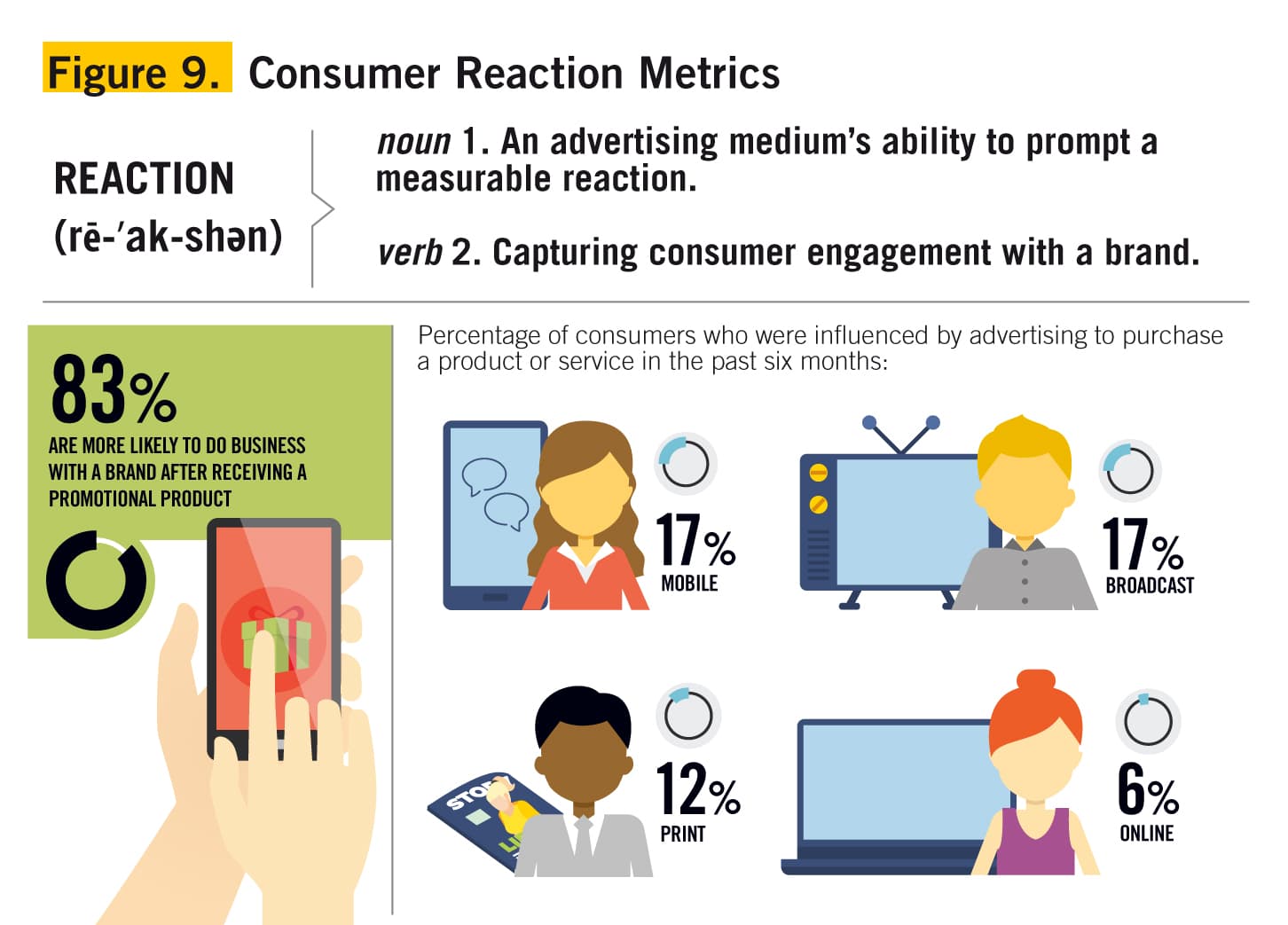
To remain competitive, advertising must relate to the target audience and provide purpose. This allows a greater opportunity to facilitate engagement and build consumer trust, leading to purchase. Promotional products engage and influence consumers—83 percent of whom say they would be more likely to do business with brands advertised on promotional products—and help brands offer experiences that bring people’s passions to life. Consumers not only welcome these experiences from brands, they expect it.
If you ask an advertising professional what the key to success is, you might get a version of the answer once given by Ogilvy & Mather’s chief creative officer, Stephen Vogel: “Nothing is more efficient than creative advertising. Creative advertising is more memorable, longer lasting, works with less media spending, and builds a fan community … faster.” Building relationships and offering creative solutions are what the promotional products industry is built on. Yet in a world with voice-activated personal assistants on our phones and our heart’s desire delivered at our beck and call, a Pew Research study points to an increasing “need for instant gratification and loss of patience.”
In this rapidly evolving marketplace, it is easy to save time and find quick answers, and marketers tend to shave timelines and lose sight of the need for consumer research in their marketing strategies. Advertising isn’t rocket science, but there is a science to it. Knowing your client’s target audience and how they respond in the overall advertising landscape will not only help them prioritize spending and secure your place in their budget, but also arm you with the right tools to stay ahead of the game and prepare you and your business to adapt and innovate.
Find more exclusive PPAI Research by visiting www.ppai.org/members/research.
Moumita Das is research coordinator at PPAI.
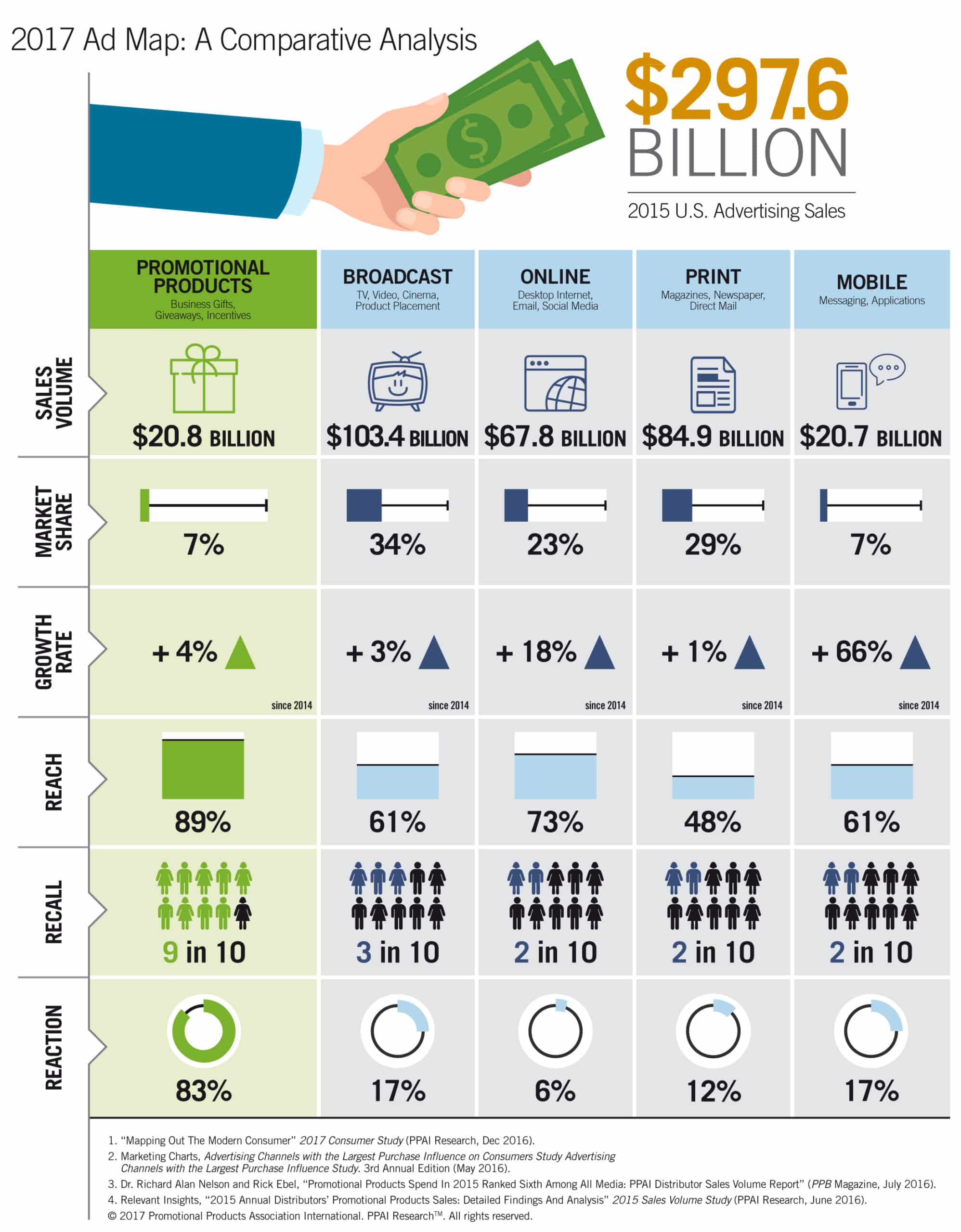
How The Right Data Saved The Sale
One of our larger clients hired a new chief marketing officer. As we were preparing for our quarterly business review, we were told that the new CMO was not convinced of the value of promotional products.
It seemed like the perfect time to share the amazing data on the effectiveness of promotional products. We pulled statistics from the 2017 Consumer Study and used the 2017 Ad Map in our presentation. The client was blown away and remarked that they were not aware of the empirical data supporting the power of promotional products.
Promotional products have an important place in the new era of advertising and I encourage you to download the 2017 Ad Map today to show your next client why promotional products are a no-brainer.
Larry Cohen is CEO of distributor Axis Promotions, a PPAI board member and liaison to the PPAI Market Research Committee.


